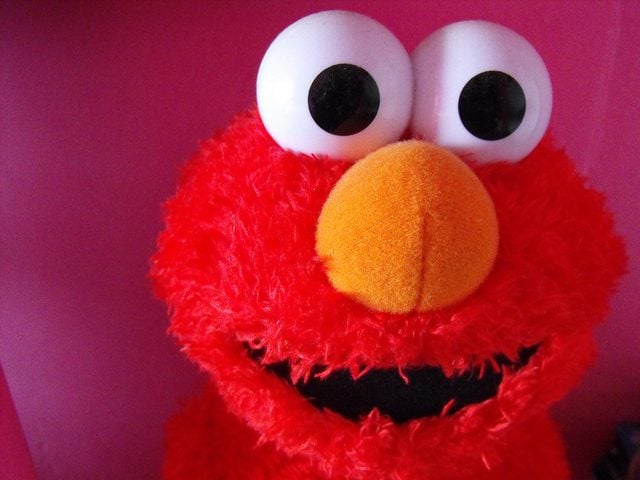I loved Sesame Street when I was a kid. In fact, fascination with the show lasted longer that it did for most other kids, to the point at which I realized bringing up current plot lines at the elementary school lunch table was socially suicidal behavior. I remember watching new episodes through around 1990, but my Sesame Street mania gave me a sense of its two decade history. As the youngest of three children, its presence in my childhood home was well-established when I arrived. Games, books, toys, VHS tapes, you name it.
And the songs! A stack of worn LPs sat atop the Fisher Price turntable next to my bed; classics like Ernie’s Hits or Sing: The Hit Songs of Sesame Street. I remember every word, and I can tell you without question, that I’ve got two eyes, and they’re both the same size. I wouldn’t mind having my own whole pond of rubber duckies.
Like most self-respecting teenagers, I occasionally entertained fond remembrances of the characters or songs, but my own Sesame Street experience faded into the distant past. That was fine, of course. It was one of those beloved childhood things we put away as we grow up.
Those of us who loved the pre-1990 version of the show found it puzzling when the Tickle Me Elmo doll craze swept the nation that one Christmas shopping season. “Elmo?” The oldest generations of viewers had never known the furry red Muppet as anything other than an extra, “anything” character. A few of us remember him occasionally interacting with the human characters, or unwittingly helping Kermit teach a lesson by just annoying the hell out of him.
But Elmo wasn’t the star of Sesame Street, and a “Tickle Me Elmo” made as much sense as a “Milk Me Gladys the Cow” or a “Play-My-Piano Don Music.”
Little did we know the show we knew and loved had been hijacked by what we would later call the “Little Red Menace.”
I have a two-year-old son of my own now. Though my wife and I allow him little screen time, we’ve let him watch some newer Sesame Street episodes on occasion when he’s sick and miserable. It’s nothing like I remember. The classic Muppets – Big Bird, Snuffy, Oscar the Grouch, Ernie, Bert, Cookie Monster, Grover, and the Count – appear sporadically at best, often in recycled sketches from decades earlier. The human characters have also been reduced or let go entirely (They fired Bob McGrath, for God’s sake!).
It’s mostly just Elmo…lots and lots of Elmo…and it’s simply intolerable. There’s no one to stop him, to rein him in and expand his myopic, narcissistic perspective. Nobody knowingly listens to his third-person stream of consciousness and shows him a better way. The Street revolves around him, his whiny falsetto monologue, and his chronically overstimulated impulses.
I needed to find out what had happened. Naturally, I googled “who killed Sesame Street.” Lo and behold, I’m not the first viewer-turned-parent to notice this. In his brilliant article, “How Elmo Ruined Sesame Street,” Kevin Wang captures the essence of Sesame Street’s downward spiral:
Rarely, if ever, is Elmo’s innocence challenged, or is he forced to think about someone’s happiness other than his own. He spends most of his time hanging out with Zoe, Abby, Telly, and Baby Bear—Muppets who share his emotional maturity, and unlike Grover, Kermit, and Ernie, do nothing to push him. In fact, he is the de facto leader of his group—the dialogue lowers to Elmo’s level, rather than rising to an older character’s. And while this is cute and fun, it gets old fast, and it doesn’t really go anywhere. Elmo is learning about counting to four and different shapes, but he’s not learning a whole lot of life lessons. At his worst, Elmo encourages immature behavior rather than discouraging it.
Basically, Sesame Street now sucks, and the Little Red Menace is responsible. It’s annoying, petulant, and trite, and with Elmo hogging the spotlight, has managed to become what adults have always hated about mindless children’s entertainment. Silliness with lots of frenetic energy. Sensory stimulation, without any real engagement. It requires nothing and it offers very little.
In fact, it reminds me a little bit of what the church has done with worship.
There is a little Elmo in all of us. He’s that little child deep down inside, the one who longs to play and be silly, unencumbered by social context. It’s that sad little guy who comes out when we’re irrationally afraid, or fear we’ve been slighted or misunderstood. If we dig down further, we might tap into the sense of total dependence only a little child could muster, and access the childlike faith Jesus demands. Being in touch with this Elmo is a good thing. He reminds us to take time for our feelings, to grieve childhood trauma, to recover a healthy sense of wonder and awe, and to identify with the little ones our Savior held dear.
But we are no longer little children, and our good God calls us to grow out of our self-centeredness and into a church for the whole world.
In allowing the contemporary worship movement, the church has capitulated to that Elmo in all of us. He demands an easy, entertaining, sensory experience. So pastors ignore the broader themes of Holy Scripture, handing our little nuggets as self-help advice. Lead singers, with their wails and gyrations, model self-indulgence to a passive audience. Prayers are cooked up on our behalf by one dude with a Shure mic. We sing silly songs, written by the Elmos among us without any help from a Maria or Luis.
We construct ad hoc orders of worship that sell neat, tidy entertainment packages to a targeted audience. We remind our groupies that God can kiss our boo-boos and make us happy again. The worship industry has completely redefined what it means to be a worshiping church. Churches offer preferentially-based smorgasbords of worship options, from which we pick whatever kind of jesusy entertainment our inner Elmo finds appealing at the moment. We are reinforcing the immaturity, rather than fostering fervent discipleship.
Bluntly, in our age of preferential worship, we are seeing our church leaders shirking their responsibility to be Kermits and Gordons and Susans and Bobs who interact with our inner Elmos, calling us to look past the ends of our noses, teaching us to be in tune to the work of redemption Jesus has ushered into a red, ugly, furry, menacing world. A world in which we see those little Elmos all grown up, furry red adults, wreaking the destructive force of their demanding immaturity and self-preoccupation onto the culture around them. The Elmo-centric pseudo-liturgy of the contemporary church will inevitably lead the church to the worship of self.
Elmo needs something more. Elmo needs to be challenged, engaged, and gently confronted with the dire reality going on around him.
Kinda like what Sesame Street used to do. Anyone remember this?
The value of corporate worship isn’t to give Elmo some sort of structured playtime. In fact, the historic worship of the church has been the perfect counter to our inner three-year-olds. Worship is not an outlet for expression, but a discipline for impression. It gently, repeatedly confronts us with a metanarrative that makes sense out of the frenetic chaos in and around us. We simply can’t sit around and worship like Mr. Hooper is still with us. He’s dead, and when people die, they don’t come back. The curse is real. The church’s worship must help its Elmos and Big Birds and Herry Monsters cope with reality and develop the maturity needed to confront the evil and injustice with the Good News.
How do we do that? The same way we always have. Through the rich and refined language of historic liturgy. Through strong singing and beautiful, dignified melodies that honor the truth of the gospel in poetic form. Through the disciplined presentation of Scripture. Through symbols pregnant with meaning, reminding us of our lifelong need of grace. Through the powerful culmination of worship in the Eucharistic feast. Through strong men and women who will step up and be pastors, so that when Elmo asks why worship looks so different, they won’t just add another service to appease him. Elmo doesn’t need to be appeased, overloaded with passive entertainment. He needs to be thoughtfully engaged, encouraged, and inspired.
Elmo worries about Elmo, and Elmo alone. There is so much more he needs to learn, and he won’t get there by himself.
Church, it’s time to stop letting Elmo run the show.
Photos:
Flickr, creative commons 2.0














